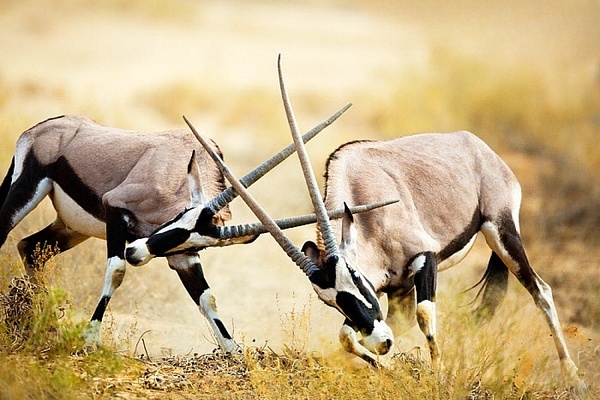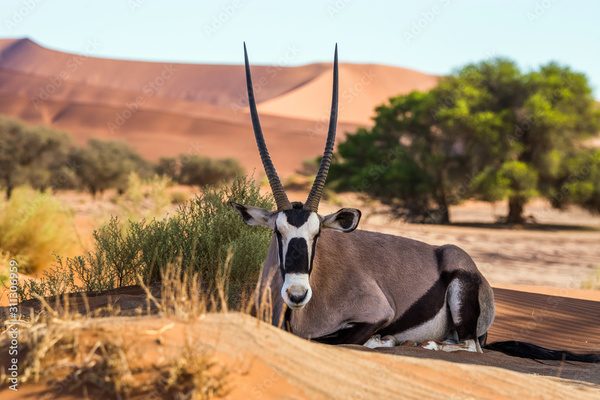The gemsbok (scientific name: Oryx gazella), commonly known as the South African oryx, is a remarkable antelope native to the arid regions of southern Africa. Known for its striking appearance, incredible adaptability, and distinct behaviors, the gembok is an iconic species of the African savanna. This article will dive deep into the various aspects of the gembok, exploring its taxonomy, physical features, distribution, behavior, conservation status, and more.
The gembok (Oryx gazella) is part of the family Bovidae, a diverse group that includes antelopes, cattle, and goats. The genus Oryx consists of four species of large antelope, with Oryx gazella being one of the most prominent. These animals are often referred to as "true oryx," and the South African oryx is one of the best-known species in the genus.
Kingdom: Animalia
Phylum: Chordata
Class: Mammalia
Order: Artiodactyla
Family: Bovidae
Genus: Oryx
Species: Oryx gazella
The South African oryx is often confused with other species in the Oryx genus, such as the Arabian oryx (Oryx leucoryx) and the scimitar-horned oryx (Oryx dammah), but the gembok's specific traits set it apart.

Gemboks are known for their striking and distinctive physical features. They are medium to large-sized antelopes with robust bodies, long legs, and impressive horns.
Body Length: Adult gemboks typically range from 1.2 to 2 meters in length.
Weight: Adult males usually weigh between 200-240 kg, while females are slightly smaller, around 160-200 kg.
Horns: The most notable characteristic of the gembok is its long, straight horns. These can grow up to 80 cm in length and are used for defense and dominance displays.
Coloration: Gemboks have a unique coat color, with a light tan or grayish-brown body and distinct black markings along their face, legs, and underbelly. These markings help with camouflage in the arid environments they inhabit.
Lifespan: Gemboks can live up to 20 years in the wild, though their lifespan is often shorter due to predation and environmental challenges.
The gembok is primarily found in the southern regions of Africa, specifically in countries like South Africa, Namibia, Botswana, and parts of Zimbabwe. They thrive in savannas, deserts, and semi-arid regions, where water is scarce but vegetation is available for grazing.
The species has adapted to survive in harsh conditions, capable of going without water for extended periods by utilizing moisture from their food and having specialized kidneys that conserve water. While they have a limited range compared to other African antelopes, their populations in certain protected areas are stable.
Social Structure and Daily Activities: Gemboks are herbivores, feeding on a variety of grasses, shrubs, and fruits. They are well-adapted to life in hot, dry environments, with a social structure that revolves around herding behavior. Females typically live in smaller groups, while males are solitary or form bachelor groups.
These antelopes are highly territorial and will defend their home ranges vigorously, especially the dominant males, who use their impressive horns to fight for access to mates.
Gemboks are non-migratory, unlike some other African antelope species that move with the rains. Instead, they are nomadic, often moving within a defined area to find food and water. They can adjust their movements based on the seasonal availability of resources, particularly water sources.
The South African oryx is known for its adaptability in feeding. During dry spells, they are capable of surviving on low-water-content vegetation, such as thorny bushes and roots. Gemboks often dig for water when surface sources dry up. Their ability to go without water for days or weeks gives them a significant advantage in arid environments.
Their diet primarily consists of grasses and herbs, but they also feed on fruits and seeds, which provide vital nutrients during harsher seasons.
Gemboks have a breeding season that peaks during the rainy season, which allows their offspring to be born when food resources are most abundant. Mating is competitive among males, and dominant males will establish territories where they can control access to females.
Gestation period: Around 270 days (approximately 9 months).
Offspring: A single calf is born after the gestation period, usually in the spring. The calf stays hidden for the first few weeks to avoid predators.
Females give birth once every 2-3 years, and the mother is extremely protective of her calf. Calves typically begin grazing alongside their mothers at around two months of age.

The South African oryx was once classified as Near Threatened due to hunting pressures and habitat loss. However, thanks to conservation efforts, its status has improved.
Conservation Status: Currently listed as Least Concern by the International Union for Conservation of Nature (IUCN).
Threats: While not under immediate threat, the gembok faces potential risks from habitat destruction, human-wildlife conflict, and poaching.
Gemboks have significant cultural value in many African societies. Their striking appearance and symbolism of endurance and survival make them a revered species. They are also of economic importance, especially in ecotourism. South Africa, Namibia, and Botswana benefit from wildlife tourism, with gemboks being a prominent species in safari experiences.
In addition, the gembok's hides have historically been used for leather products, and its meat is considered a delicacy in some regions.
The gembok belongs to the genus Oryx, which contains other closely related species. Here's a comparison table of the gembok and its closest relatives:
| Species | Common Name | Habitat | Conservation Status |
|---|---|---|---|
| Oryx gazella | Gembok / South African Oryx | Southern Africa | Least Concern |
| Oryx leucoryx | Arabian Oryx | Arabian Peninsula | Extinct in the Wild (Reintroduced) |
| Oryx dammah | Scimitar-horned Oryx | North Africa | Extinct in the Wild (Reintroduced) |
| Oryx beisa | Beisa Oryx | East Africa | Near Threatened |
The gembok (Oryx gazella), or South African oryx, is a remarkable and resilient species perfectly adapted to life in some of the harshest environments on Earth. Through its striking physical appearance, unique behaviors, and vital role in the ecosystem, the gembok is an essential part of southern Africa’s natural heritage. Conservation efforts have played a crucial role in stabilizing its population, ensuring that this majestic antelope will continue to thrive in the wild for generations to come.
References
IUCN Red List: Oryx gazella
African Wildlife Foundation (AWF)
Smithsonian's National Zoo: Oryx gazella
Macdonald, D., ed. (2010). The Encyclopedia of Mammals.
animal tags: Bovidae
We created this article in conjunction with AI technology, then made sure it was fact-checked and edited by a Animals Top editor.